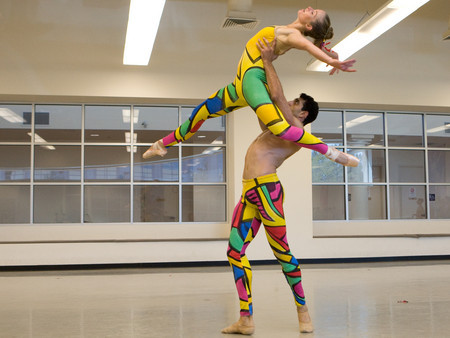Cuckoo for Coco Buffs

First Up: Coco and Co.
Dance meets design when Nevada Ballet Theatre opens its season this weekend with the three-piece "Timeless Innovation" featuring a balletic celebration of the life of Coco Chanel by James Canfield, who also created "Jungle," another of the program’s pieces. Both make their Vegas premieres as George Balanchine’s "Rubies" rounds out the bill.
"It’s a capsule of a tribute to her life," says artistic director Canfield. "It’s got humor in it, and despair, love and romance."
A fashion icon and colorful character, Chanel’s had her life retold in numerous artistic interpretations. Films include this year’s "Coco Avant Chanel" ("Coco Before Chanel") starring Audrey Tautou as the young Coco, and "Coco Chanel & Igor Stravinsky," about her love affair with the legendary composer, as well as 2008’s TV movie "Coco Chanel," starring Shirley MacLaine as the fashionista at age 70. She also was portrayed onstage when a Broadway musical earned Katharine Hepburn a Tony nomination in 1969.
Canfield’s "Coco" uses a 1940s setting and incorporates inventive visual elements such as a floating violin, as well as couture costumes. Accompanying "Coco" is the music of French chanteuse Edith Piaf.
"She had a fabulous life that relates so well to this piece, and there was something in her voice — if Coco was a singer, I think she would have sounded like Edith Piaf," says Katarina Svetlova, who is staging "Coco" with one female and five male dancers. "The first dance Coco dances with the men, (Piaf’s) voice is very flirtatious. Whenever Edith is singing and Coco is dancing, (Canfield) just chose pieces that went exactly with the tone of the moment we needed."
Svetlova also delved deep into research on the clothes queen. "I watched the movies on her before we started and read all the books. There were a lot of men in her life, so we bring that into the piece as well." One was English polo player Arthur "Boy" Capel, the love of Chanel’s life and an influence on her style. In the ballet, Chanel performs what Svetlova calls "a competitive dance" with Capel.
Lest we forget the indelible fashions from this incredible designer, Svetlova notes that "the first white pants outfit is very much designed after her, from a picture of her sitting on her lover’s shoulder and she has this huge smile on her face. At the end, she has this flowing, black, lacy, gorgeous dress with jewels up the wazoo. It reflects what a more mature woman would wear."
Elsewhere on the program, Balanchine’s "Rubies" is a third of "Jewels," the full-length ballet from the master. " ‘Ballet,’ Mr. Balanchine said, ‘is woman,’ " Canfield recalls. "And the woman is a very significant figure throughout the entire evening of dance. The predominant gender in ‘Rubies’ is women."
A plotless piece, as are most Balanchine ballets, "Rubies" is jazzy and playful, emblematic, Canfield says, of Balanchine’s brilliance. "When he was the new voice in dance, when he came out of Russia, he took the romantic ballets and those structures of symmetry and made them asymmetrical."
His creations, Canfield adds, are an important inclusion. "It’s always important to do at least one, if not more Balanchine works in a season," Canfield says. "It’s what (dancers) utilize every single day, the classroom steps and technique, so it keeps that in check for the dancers."
Completing the season debut is Canfield’s lushly rendered "Jungle" that juxtaposes the literal jungle of the animal kingdom and the urban jungle of man, set against fluorescent, multicolored backdrops as Canfield’s athletic choreography simulates movements of survival through seven scenes. The throbbing rhythms of worldbeat music by the British group Future Sound of London underscore the action in a piece showcasing the entire company, as well as solos and duets.
"It’s an abstract concept, but a fantastic piece of work," says Tracy Taylor, who is staging "Jungle," noting that the survival-of-the-fittest theme is evident at the start when, as one person performs solo, another circles them in their own space and soon pushes them out. "It’s high energy, there’s a lot visually, the costumes are amazing. There’s wild animal and jungle noises, in the sense of it’s a jungle out there. For example, if you would be walking the streets of New York, your senses would be more aware than if you were walking in the countryside."
Using a childhood fascination with untamed creatures — he was a fan of TV’s "Mutual of Omaha’s Wild Kingdom" — Canfield fused it with inspiration from his experience amid the heightened energy of New York City, borrowing its tone and tempo to pump "Jungle" full of intensity.
"It’s extreme, thriving, pulsing, energetic, aggressive, edgy, what New York felt like to me," he says about the passions he poured into the piece. And about the city that famously never sleeps — or even catches a catnap.
"It’s a faster pace, the way you walk on the street, you don’t casually walk around and look up. You have to have a definite destination in mind and your attitude is very forthright. That’s why people think people in New York are hard to get to know. They’re not. They’re just honest — ‘we’ve got to get there.’ There’s a heartbeat to that city like nowhere else in the world."
Next time you’re back East and a Manhattan crowd sweeps you through its concrete canyons, keep an eye on the stylish blur of couture barreling down the avenue.
Welcome to the jungle, Coco.
Contact reporter Steve Bornfeld at sbornfeld@ reviewjournal.com or 702-383-0256.